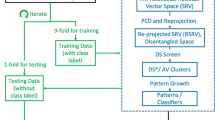Abstract
Mining the most interesting patterns from multiple phenotypes medical data poses a great challenge for previous work, which only focuses on bi-phenotypes (such as abnormal vs. normal) medical data. Association rule mining can be applied to analyze such dataset, whereas most rules generated are either redundancy or no sense. In this paper, we define two interesting patterns, namely VP (an acronym for “Vital Pattern”) and PP (an acronym for “Protect Pattern”), based on a statistical metric. We also propose a new algorithm called MVP that is specially designed to discover such two patterns from multiple phenotypes medical data. The algorithm generates useful rules for medical researchers, from which a clearly causal graph can be induced. The experiment results demonstrate that the proposed method enables the user to focus on fewer rules and assures that the survival rules are all interesting from the viewpoint of medical domain. The classifier build on the rules generated by our method outperforms existing classifiers.
The work was supported by the “fifteen” tackle key problem project of National Science and Technology Department under grant no.2004BA721A05.
Preview
Unable to display preview. Download preview PDF.
Similar content being viewed by others
References
Agrawal, R., Imielinski, T., Swami, A.: Mining association rules between sets of items in large databases. In: Proc. of ACM SIGMOD 1993 Conference, pp. 207–216 (1993)
Decker, K.M., Focardi, S.: Technology overview: A report on data mining, technical report cscs tr-95-02. In Swiss Scientific Computing Center (1995)
Li, J., Wong, L.: Using rules to analyse bio-medical data: A comparison between C4.5 and PCL. In: Dong, G., Tang, C., Wang, W. (eds.) WAIM 2003. LNCS, vol. 2762, pp. 254–265. Springer, Heidelberg (2003)
Zhou, Z., Jiang, Y.: Medical diagnosis with c4.5 rule preceded by artificial neural network ensemble. IEEE Transactions on Information Technology in Biomedicine 7, 37–42 (2003)
Brossette, J.S.E., Sprague, A.P., Moser, S.A.: Associarion rules and data mining in hospital infection control and public health surveillance. Journal of American Medical Informatics Association 5(4), 373–381 (1998)
Ohsaki, M., Sato, Y., Yokoi, H., Yamaguchi, T.: A rule discovery support system for sequential medical data in the case study of a chronic hepatitis dataset. In: Proc of the ECML/PKDD 2003 Discovery Challenge Workshop, pp. 154–165 (2003)
Liu, B., Hsu, W., Ma, Y.: Pruning and summarizing the discovered associations. In: Proc. of 5th Intl. Conf. on Knowledge Discovery and Data Mining (1999)
Kamber, M., Shinghal, R.: Evalusting the interestingness of characteristic rules. In: Proc. of 2nd Intl. Conf. on Knowledge Discovery and Data Mining, pp. 263–266 (1996)
Author information
Authors and Affiliations
Editor information
Editors and Affiliations
Rights and permissions
Copyright information
© 2006 Springer-Verlag Berlin Heidelberg
About this paper
Cite this paper
Yin, Y., Zhang, B., Zhao, Y., Wang, G. (2006). Mining the Most Interesting Patterns from Multiple Phenotypes Medical Data. In: Greco, S., et al. Rough Sets and Current Trends in Computing. RSCTC 2006. Lecture Notes in Computer Science(), vol 4259. Springer, Berlin, Heidelberg. https://doi.org/10.1007/11908029_72
Download citation
DOI: https://doi.org/10.1007/11908029_72
Publisher Name: Springer, Berlin, Heidelberg
Print ISBN: 978-3-540-47693-1
Online ISBN: 978-3-540-49842-1
eBook Packages: Computer ScienceComputer Science (R0)




